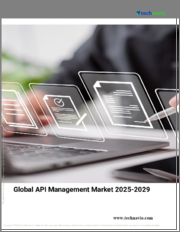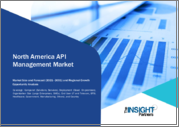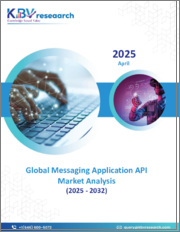
|
시장보고서
상품코드
1733222
세계의 API 관리 시장 규모 : 컴포넌트별, 전개 형태별, 지역 범위별, 예측Global API Management Market Size By Component (Solutions, Services), By Deployment (On-Premises, Cloud), By Geographic Scope And Forecast |
||||||
※ 본 상품은 영문 자료로 한글과 영문 목차에 불일치하는 내용이 있을 경우 영문을 우선합니다. 정확한 검토를 위해 영문 목차를 참고해주시기 바랍니다.
API 관리 시장 규모 및 전망
API 관리 시장 규모는 2024년 43억 7,000만 달러로 평가되었고, 2026-2032년 28.77%의 연평균 복합 성장률(CAGR)로 성장하여 2032년에는 330억 7,000만 달러에 이를 것으로 예측됩니다.
- API 관리는 안전하고 확장 가능한 환경에서 용도 프로그래밍 인터페이스(API)를 설계, 공개, 문서화, 분석하는 프로세스로, API의 개발, 배포, 모니터링을 용이하게 하고 수명주기 동안 적절하게 관리할 수 있는 중앙 집중식 플랫폼을 구축하는 것을 포함합니다. 플랫폼 구축이 포함됩니다. 조직은 API 관리를 통해 서로 다른 시스템, 서비스, 사용자 간의 커뮤니케이션을 간소화하고, 타사 용도 및 내부 시스템과 효율적으로 통합할 수 있도록 합니다. 이는 API가 독립적인 서비스 간의 가교 역할을 하는 마이크로서비스 아키텍처에서 매우 중요합니다.
- 기업들이 디지털 전환 전략을 점점 더 많이 채택함에 따라 효율적인 API 관리에 대한 수요는 증가할 것으로 예측됩니다. 클라우드 컴퓨팅, 사물인터넷(IoT), 인공지능(AI)의 부상으로 API는 서로 다른 기술과 플랫폼 간의 원활한 통합을 위해 더욱 필수적인 요소가 될 것으로 보입니다.
- API 성능 최적화, 보안 프로토콜 강화, AI를 활용한 일상적인 작업 자동화, 보다 정교한 API 관리 솔루션, API 생태계가 확장되고, API 관리는 혁신을 가능하게 하고, 개발자 경험을 향상시키며, 기업의 새로운 수익원을 창출하는 데 매우 중요한 요소입니다. 새로운 수익원을 창출하는 데 있어 매우 중요한 요소가 될 것입니다.
세계 API 관리 시장 역학
세계 API 관리 시장을 형성하는 주요 시장 역학은 다음과 같습니다.
주요 시장 성장 촉진요인
- 클라우드 기반 기술 채택 증가: 클라우드 컴퓨팅으로의 급속한 전환으로 API 관리 솔루션에 대한 수요가 증가하고 있으며, 가트너에 따르면, 전 세계 최종 사용자의 퍼블릭 클라우드 서비스 지출은 2021년 4,109억 달러에서 2022년 4,947억 달러로 20.4% 증가할 것으로 예측됩니다. 20.4% 증가한 4,947억 달러에 달할 것으로 전망하고 있습니다. 이러한 클라우드 도입 확대는 클라우드 기반 용도과 서비스의 원활한 통합과 보안을 보장하기 위한 견고한 API 관리가 필요합니다.
- 디지털 전환에 대한 중요성 증가: 모든 산업에서 조직은 디지털 전환을 우선순위에 두고 있으며, 이는 API 사용량 및 관리 요구 증가로 이어지고 있습니다. IDC는 2023년까지 디지털 전환에 대한 지출이 2조 3,000억 달러에 달할 것으로 전망했습니다. 000억 달러에 달하고, 전체 ICT 투자의 53%를 차지할 것으로 예측했습니다. 이러한 디지털 이니셔티브에 대한 막대한 투자는 업무를 간소화하고 고객 경험을 향상시키는 API 관리 솔루션에 대한 수요를 촉진하고 있습니다.
- API 보안에 대한 관심 증가: 사이버 위협이 증가함에 따라 API 보안은 기업들에게 매우 중요한 관심사가 되고 있으며, Salt Security의 보고서에 따르면 API 공격은 2021년에 전년 대비 681% 증가했습니다. 가 우려할 만한 속도로 증가함에 따라 기업들은 강력한 보안 기능과 위협 방어 기능을 제공하는 종합적인 API 관리 솔루션에 투자하고 있습니다.
주요 과제
- 보안 및 데이터 프라이버시 API 관리는 사내 서비스를 외부에 공개하는 것이므로 데이터 유출 및 사이버 공격의 위험이 높아지며, API를 통해 기밀 데이터를 관리하기 위해서는 암호화, 접근 제어, 정기적인 보안 감사 등 엄격한 보안 조치가 필요합니다. GDPR(EU 개인정보보호규정)이나 CCPA와 같은 규제가 강화되는 가운데, 사용 편의성을 유지하면서 컴플라이언스를 보장하는 것은 어려운 과제입니다. 주요 기업들은 종종 통합을 위한 개방성과 적절히 대처하지 않으면 값비싼 침해로 이어질 수 있는 취약점에 대한 보안 조치의 적절한 균형을 찾는 데 어려움을 겪습니다.
- 확장성 문제: API에 대한 수요가 증가함에 따라 대량의 API 요청을 관리하는 것은 특히 갑작스러운 트래픽 폭증을 경험하는 기업에게 큰 도전이 되고 있으며, API 관리 플랫폼은 대기 시간이나 다운타임 없이 효과적으로 확장할 수 있어야 합니다. 확장에 실패하면 시스템 중단, 성능 저하, 사용자 경험 저하로 이어질 수 있습니다. 많은 기업들이 트래픽 패턴을 예측하고 API 관리 솔루션이 급격한 성장과 갑작스러운 사용량 급증에 대응할 수 있도록 하는 데 어려움을 겪고 있습니다.
- API 버전 관리 및 라이프사이클 관리: 여러 버전의 API를 관리하면서 하위 호환성을 보장하는 것은 복잡합니다. 조직은 기존 버전에 의존하는 기존 사용자에게 혼란을 주지 않고 API를 업데이트하는 데 어려움을 겪는 경우가 많습니다. 적절한 버전 관리와 라이프사이클 관리를 통해 고객에게 다운타임이나 문제를 일으키지 않고 비추천 API를 단계적으로 폐지할 수 있습니다. 그러나 부적절한 변경 계획이나 불충분한 커뮤니케이션은 마찰을 일으키고 사용자 경험에 영향을 미치며 API의 신뢰성을 떨어뜨릴 수 있습니다.
주요 동향
- 마이크로서비스 아키텍처의 부상: 용도를 더 작고 독립적인 서비스로 분해하는 마이크로서비스 아키텍처는 효과적인 API 관리에 대한 수요를 크게 증가시키고 있으며, API는 이러한 마이크로서비스 간의 통신을 가능하게 하는 데 필수적입니다. 기업들이 더 나은 확장성과 유연성을 위해 모놀리식 시스템에서 마이크로서비스로 전환함에 따라, 이러한 분산 시스템을 모니터링하고, 보안을 보장하며, 확장할 수 있는 API 관리 도구에 대한 필요성이 증가하고 있습니다. 이러한 추세는 용도의 민첩성을 높이고, 개발 주기를 단축하고, 유지보수를 용이하게 해야 할 필요성에 의해 추진되고 있습니다.
- 사물인터넷(IoT)의 API 활용 확대: 사물인터넷(IoT)은 디바이스, 용도, 네트워크 간의 통신을 가능하게 하는 API에 크게 의존하고 있으며, IoT 생태계가 수십억 개의 커넥티드 디바이스로 확장됨에 따라 API의 복잡성, 보안, 확장성 관리가 필수적입니다. 관리가 필수적입니다. 이러한 추세는 헬스케어, 제조, 운송 등 다양한 산업에서 스마트 디바이스의 도입이 진행되고 있는 것을 배경으로 하고 있습니다. 효과적인 API 관리는 IoT 디바이스, 시스템, 플랫폼 간의 원활한 통합을 보장하고, 혁신을 촉진하며, 실시간 데이터 처리를 가능하게 하기 위해 필수적입니다.
- 하이브리드 및 멀티 클라우드 환경으로의 전환: 벤더 종속을 피하고 다양한 클라우드 서비스의 장점을 활용하기 위해 하이브리드 및 멀티 클라우드 전략을 채택하는 기업이 증가함에 따라, 이러한 다양한 환경에 걸친 API 관리가 중요해지고 있습니다. API 관리 플랫폼은 On-Premise, 프라이빗, 퍼블릭 클라우드의 원활한 통합, 보안, 모니터링을 지원해야 합니다. 이러한 추세는 유연성, 비용 최적화, 서로 다른 클라우드 환경 간에 워크로드를 자유롭게 이동할 수 있는 기능을 원하는 기업들에 의해 추진되고 있으며, 상호운용성을 보장하는 강력한 API 관리 솔루션에 대한 수요가 증가하고 있습니다.
목차
제1장 세계의 api 관리 시장 서론
- 시장 개요
- 조사 범위
- 전제조건
제2장 주요 요약
제3장 VERIFIED MARKET RESEARCH의 조사 방법
- 데이터 마이닝
- 밸리데이션
- 1차 자료
- 데이터 소스 리스트
제4장 세계의 API 관리 시장 전망
- 개요
- 시장 역학
- 성장 촉진요인
- 성장 억제요인
- 기회
- Porter's Five Forces 모델
- 밸류체인 분석
제5장 세계의 API 관리 시장, 컴포넌트별
- 개요
- API 분석
- API 플랫폼
- 보안
- 서비스
제6장 API 관리 세계 시장 : 전개 유형별
- 개요
- 클라우드
- On-Premise
제7장 API 관리 세계 시장 : 지역별
- 개요
- 북미
- 미국
- 캐나다
- 멕시코
- 유럽
- 독일
- 영국
- 프랑스
- 기타 유럽
- 아시아태평양
- 중국
- 일본
- 인도
- 기타 아시아태평양
- 기타
- 라틴아메리카
- 중동 및 아프리카
제8장 세계의 API 관리 시장 경쟁 구도
- 개요
- 기업의 시장 순위
- 주요 개발 전략
제9장 기업 개요
- IBM Corporation
- Red Hat
- SAP SE
- Oracle
- CA Technologies
- Microsoft Corporation
- MuleSoft
- Broadcom company
- TIBCO
제10장 부록
- 관련 조사
API Management Market Size And Forecast
API Management Market size was valued at USD 4.37 Billion in 2024 and is projected to reach USD 33.07 Billion by 2032, growing at a CAGR of 28.77% from 2026 to 2032.
- API Management refers to the process of designing, publishing, documenting, and analyzing Application Programming Interfaces (APIs) in a secure and scalable environment. It involves the creation of a centralized platform that facilitates the development, deployment, and monitoring of APIs, ensuring they are properly managed throughout their lifecycle. Organizations use API Management to streamline communication between different systems, services, and users, enabling them to integrate with third-party applications and internal systems efficiently. This is critical in microservices architecture, where APIs act as bridges between independent services.
- As businesses increasingly adopt digital transformation strategies, the demand for efficient API Management is expected to grow. With the rise of cloud computing, the Internet of Things (IoT), and artificial intelligence, APIs will become even more essential for enabling seamless integration between different technologies and platforms.
- We can expect more sophisticated API management solutions that leverage AI for optimizing API performance, enhancing security protocols, and automating routine tasks. API ecosystems will expand, making API Management a crucial component in enabling innovation, enhancing developer experiences, and driving new revenue streams for businesses.
Global API Management Market Dynamics
The key market dynamics that are shaping the global API management market include:
Key Market Drivers:
- Increasing Adoption of Cloud-Based Technologies: The rapid shift towards cloud computing is driving the demand for API management solutions. According to Gartner, worldwide end-user spending on public cloud services was forecast to grow 20.4% in 2022 to a total of $494.7 billion, up from $410.9 billion in 2021. This growth in cloud adoption necessitates robust API management to ensure seamless integration and security of cloud-based applications and services.
- Rising Importance of Digital Transformation Initiatives: Organizations across industries are prioritizing digital transformation, leading to increased API usage and management needs. IDC predicted that by 2023, digital transformation spending would reach $2.3 trillion, accounting for 53% of all ICT investment. This substantial investment in digital initiatives is driving the demand for API management solutions to streamline operations and enhance customer experiences.
- Growing focus on API Security: With the increasing number of cyber threats, API security has become a crucial concern for businesses. According to a report by Salt Security, API attacks increased by 681% in 2021 compared to the previous year. This alarming growth in API -related security incidents is prompting organizations to invest in comprehensive API management solutions that offer robust security features and threat protection capabilities.
Key Challenges:
- Security and Data Privacy: API management involves exposing internal services to external parties, increasing the risk of data breaches and cyber-attacks. Managing sensitive data through APIs requires strict security measures like encryption, access control, and regular security audits. With increasing regulations (like GDPR and CCPA), ensuring compliance while maintaining ease of use is a challenge. Companies often struggle to find the right balance between openness for integration and safeguarding against vulnerabilities, which can lead to costly breaches if not properly addressed.
- Scalability Issues: As the demand for APIs grows, managing large volumes of API requests becomes a challenge, particularly for companies that experience sudden traffic spikes. API management platforms must scale effectively without causing latency or downtime. Failure to scale can lead to system outages, reduced performance, and a poor user experience. Many businesses face difficulties in predicting traffic patterns and ensuring their API management solutions are equipped to handle rapid growth or sudden spikes in usage.
- API Versioning and Lifecycle Management: Managing multiple versions of an API while ensuring backward compatibility is complex. Organizations often struggle with updating APIs without disrupting existing users who depend on older versions. Proper version control and lifecycle management ensure that deprecated APIs is phased out without causing downtime or issues for clients. However, improper planning or poor communication of changes can cause friction, affecting the user experience and eroding trust in the API's reliability.
Key Trends:
- Rise of Microservices Architecture: Microservices architecture, which involves breaking down applications into smaller, independent services, has significantly increased the demand for effective API management. APIs are essential in enabling communication between these microservices. As businesses transition from monolithic systems to microservices to achieve better scalability and flexibility, the need for API management tools that can monitor, secure, and scale these distributed systems grows. This trend is driven by the necessity to improve application agility, faster development cycles, and easier maintenance.
- Growing Use of APIs in IoT: The Internet of Things (IoT) relies heavily on APIs to enable communication between devices, applications, and networks. As the IoT ecosystem expands with billions of connected devices, managing the complexity, security, and scalability of APIs becomes essential. This trend is driven by the growing adoption of smart devices in various industries, including healthcare, manufacturing, and transportation. Effective API management is critical for ensuring seamless integration between IoT devices, systems, and platforms, promoting innovation, and enabling real-time data processing.
- Shift to Hybrid and Multi-cloud Environments: As businesses increasingly adopt hybrid and multi-cloud strategies to avoid vendor lock-in and leverage the best of different cloud services, managing APIs across these diverse environments becomes critical. API management platforms must support seamless integration, security, and monitoring across on-premise, private, and public clouds. This trend is driven by organizations seeking flexibility, cost optimization, and the ability to move workloads freely between different cloud environments, creating a demand for robust API management solutions that ensure interoperability.
Global API Management Market Regional Analysis
Here is a more detailed regional analysis of the API management market:
North America:
- North America, dominates the API management market due to several key factors. North America has historically been a leader in the API management market due to several key factors. The region, especially the United States, is home to many of the world's largest tech companies, including cloud service providers, software developers, and tech startups, which have driven API innovation. These companies have been at the forefront of adopting API -first strategies and microservices architectures, allowing them to build scalable, flexible systems.
- North America's robust IT infrastructure and advanced digital networks have facilitated the rapid growth of API -dependent services across various industries, from finance to healthcare, driving demand for effective API management solutions.
- Another significant factor driving API management market growth in North America is the region's large market size and favorable regulatory environment. The mature technology ecosystem in the U.S. and Canada attracts substantial investments, fostering innovation and the development of new API management tools. Companies in the region benefit from relatively supportive regulations that encourage digital transformation and technology development. As businesses increasingly rely on APIs for integrations, cloud services, and third-party collaborations, the need for efficient API management platforms continues to grow, ensuring the region's dominance in the global market.
Asia Pacific:
- The API management market in Asia-Pacific is rapidly expanding, driven by increased digitization efforts and the adoption of cloud-based technologies. Government initiatives, like as India's Digital India campaign, have played an important role, with over 1,200 government services currently available via APIs by 2023, according to the Ministry of Electronics and Information Technology. This has enabled effective integration and data interchange across many sectors, increasing the need for API management solutions.
- The region's growing fintech sector, notably in China, is driving up the API management market. The People's Bank of China reported a 15% increase in permitted third-party payment providers in 2022, underscoring the importance of APIs in financial services. Countries such as Singapore are also seeing an increase in API adoption, driven by government-backed projects such as Smart Nation, which has resulted in a 30% increase in API usage from 2021 to 2023.
- Asia's dynamic startup ecosystem, which includes key centers in Beijing, Shanghai, and Bangalore, promotes innovation and the rise of API-driven firms, according to Startup Genome in 2023. These reasons, collectively, are driving the API management market in Asia-Pacific.
TABLE OF CONTENTS
1 INTRODUCTION OF GLOBAL API MANAGEMENT MARKET
- 1.1 Overview of the Market
- 1.2 Scope of Report
- 1.3 Assumptions
2 EXECUTIVE SUMMARY
3 RESEARCH METHODOLOGY OF VERIFIED MARKET RESEARCH
- 3.1 Data Mining
- 3.2 Validation
- 3.3 Primary Interviews
- 3.4 List of Data Sources
4 GLOBAL API MANAGEMENT MARKET OUTLOOK
- 4.1 Overview
- 4.2 Market Dynamics
- 4.2.1 Drivers
- 4.2.2 Restraints
- 4.2.3 Opportunities
- 4.3 Porters Five Force Model
- 4.4 Value Chain Analysis
5 GLOBAL API MANAGEMENT MARKET, BY COMPONENT
- 5.1 Overview
- 5.2 API Analytics
- 5.3 API Platform
- 5.4 Security
- 5.5 Services
6 GLOBAL API MANAGEMENT MARKET, BY DEPLOYMENT TYPE
- 6.1 Overview
- 6.2 Cloud
- 6.3 On-Premises
7 GLOBAL API MANAGEMENT MARKET, BY GEOGRAPHY
- 7.1 Overview
- 7.2 North America
- 7.2.1 U.S.
- 7.2.2 Canada
- 7.2.3 Mexico
- 7.3 Europe
- 7.3.1 Germany
- 7.3.2 U.K.
- 7.3.3 France
- 7.3.4 Rest of Europe
- 7.4 Asia Pacific
- 7.4.1 China
- 7.4.2 Japan
- 7.4.3 India
- 7.4.4 Rest of Asia Pacific
- 7.5 Rest of the World
- 7.5.1 Latin America
- 7.5.2 Middle East and Africa
8 GLOBAL API MANAGEMENT MARKET COMPETITIVE LANDSCAPE
- 8.1 Overview
- 8.2 Company Market Ranking
- 8.3 Key Development Strategies
9 COMPANY PROFILES
- 9.1 IBM Corporation
- 9.1.1 Overview
- 9.1.2 Financial Performance
- 9.1.3 Product Outlook
- 9.1.4 Key Developments
- 9.2 Red Hat
- 9.2.1 Overview
- 9.2.2 Financial Performance
- 9.2.3 Product Outlook
- 9.2.4 Key Developments
- 9.3 SAP SE
- 9.3.1 Overview
- 9.3.2 Financial Performance
- 9.3.3 Product Outlook
- 9.3.4 Key Developments
- 9.4 Oracle
- 9.4.1 Overview
- 9.4.2 Financial Performance
- 9.4.3 Product Outlook
- 9.4.4 Key Developments
- 9.5 CA Technologies
- 9.5.1 Overview
- 9.5.2 Financial Performance
- 9.5.3 Product Outlook
- 9.5.4 Key Developments
- 9.6 Google
- 9.6.1 Overview
- 9.6.2 Financial Performance
- 9.6.3 Product Outlook
- 9.6.4 Key Developments
- 9.7 Microsoft Corporation
- 9.7.1 Overview
- 9.7.2 Financial Performance
- 9.7.3 Product Outlook
- 9.7.4 Key Developments
- 9.8 MuleSoft
- 9.8.1 Overview
- 9.8.2 Financial Performance
- 9.8.3 Product Outlook
- 9.8.4 Key Developments
- 9.9 Broadcom company
- 9.9.1 Overview
- 9.9.2 Financial Performance
- 9.9.3 Product Outlook
- 9.9.4 Key Developments
- 9.10 TIBCO
- 9.10.1 Overview
- 9.10.2 Financial Performance
- 9.10.3 Product Outlook
- 9.10.4 Key Developments
10 Appendix
- 10.1 Related Research
샘플 요청 목록



















